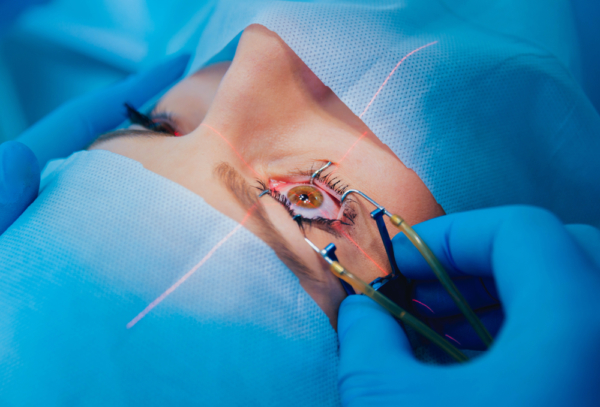LASIK (laser-assisted in situ keratomileusis) surgery is one of the most commonly performed procedures used to treat nearsightedness (myopia), and farsightedness (hyperopia), and astigmatism.
During the LASIK procedure, the cornea is reshaped to enable light to enter the eye so that it is properly focused on the retina for clearer vision.
LASIK surgery can be performed quickly; and is essentially pain-free. Vision is improved immediately, without the need for glasses or contact lenses with vision continuing to stabilize and improve over just a few days.
How is LASIK surgery performed?
Your LASIK surgeon will use a small surgical tool called a microkeratome or a femtosecond laser to create a very thin, superficial flap in your cornea. This flap when then be folded back to allow access to the underlying cornea (called the stroma) so that he or she may remove some of your corneal tissues using an excimer laser.
The excimer lasers create a cool ultraviolet light beam to ablate (remove) microscopic amounts of tissue from the cornea to reshape it. This allows the light that enters the eye to focus more accurately on the retina and results in improved vision.
The goal for nearsighted patients is to flatten the cornea. With farsighted patients, a steeper cornea is desired. Astigmatisms may be corrected with an excimer laser by smoothing an irregular cornea into a more normal shape.
After the laser ablation has reshaped the cornea, the flap is then laid back in place to cover the area where the corneal tissue was removed. Through the healing period the flap will seal to the underlying cornea to complete the healing process.
Following surgery, topical anesthetic drops are used. No bandages or stitches are required.
To determine if you are a candidate for LASIK surgery, your eye doctor will perform a thorough eye examination to ensure your eyes are healthy enough for the procedure. The shape and thickness of your cornea, along with your pupil size, refractive errors (hyperopia, myopia and astigmatism); as well as any other eye conditions will be evaluated.
Your doctor will also evaluate the tear film on the surface of your eyes, along with recommending precautionary treatment to reduce your risk of developing dry eyes following LASIK surgery.
What to expect during LASIK Surgery
LASIK typically takes less than 15 minutes to complete and is performed on each eye separately.
Numbing eye drops will be applied to your eye to prevent any discomfort prior to your procedure. You may also be given medication to help you relax.
Your eye will be positioned under a laser. An instrument called a lid speculum will be used to keep your eyelids open. Then your doctor will use an ink marker to mark your cornea before creating the flap. To prevent eye movements or loss of contact that could affect the flap quality, a suction ring is applied to the front of your eye.
Once the corneal flap is created, your doctor will then use a computer to adjust the excimer laser to match your prescription.
Your doctor will then ask you to look at a target light so that he/she may watch your eye through a microscope as the laser sends pulses of light to your cornea. The pulses from the laser light painlessly reshape your cornea. You may feel a little pressure on your eye, and you will also hear a steady clicking sound while the laser is operating.
Immediately following the completion of your LASIK procedure, you may feel a temporary burning or itching sensation. You will need someone to drive you home the day of your procedure. You may experience some blurry vision and haziness which should improve by the next morning. And, in most cases, your doctor will want to see you the next day to check your progress.
Within the next few days, your eyesight should stabilize and continue to improve. Sometimes, but rarely, it may take several weeks or longer for vision to improve. For most patients, your vision will improve immediately.
It is typically recommended that you refrain from strenuous exercise for at least a week to avoid traumatizing your eye(s) and to aid healing.
The day after your surgery, or the next time you see your eye doctor, your visual acuity will be measured to check your progress and to make sure it is safe for you to drive without glass or contact lenses.
Most LASIK patients can achieve 20/20 vision or better following surgery. However, results vary, and some may achieve only 20/40 or less. Your results will depend on many factors that your eye doctor will discuss with you during your initial examination.
Our very own Dr. ILAN Epstein, is a member of the American Academy of Ophthalmology and the American Society of Cataract and Refractive Surgery and specializes in LASIK surgery. If you’d like to find out if you’re a candidate for LASIK surgery, call 954-741-5555 to make an appointment today.







